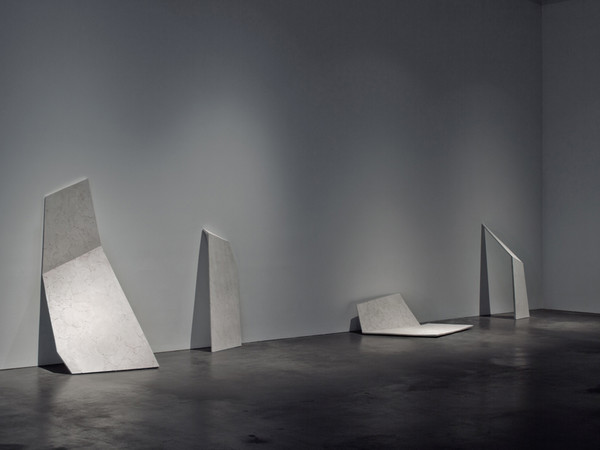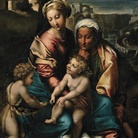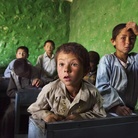Erin Shirreff. Solo show

From 02 Febbraio 2018 to 04 Marzo 2018
Bologna
Place: Palazzo De' Toschi
Address: piazza Minghetti 4/D
Times: On the weekend of ART CITY Bologna: February 2, 10 AM - 10 PM; February 3, 10 AM - midnight; February 4, 10 AM - 8 PM From February 8 to March 4, 2018: Thursday to Saturday, 11:30 AM – 6:30 PM; Sunday, 1:30 PM – 6:30 PM Closed Mondays, Tuesdays and Wednesdays
Responsibles: Simone Menegoi
Organizers:
- Banca di Bologna
- Palazzo De' Toschi
Ticket price: free entrance
Telefono per informazioni: +39 051 6571431
E-Mail info: info@bancadibologna.it
Official site: http://eventi.bancadibologna.it/erin-shirreff/
Banca di Bologna is proud to present the first solo show in Italy by Canadian-born, New York-based artist Erin Shirreff. Entirely made up of new pieces created specifically for the occasion, the exhibition offers Italian viewers their first major opportunity to experience the work of an artist who, in her early forties, can already be found in the collections of prestigious international museums such as the Centre Georges Pompidou (Paris), MoMA (New York) and the Guggenheim (New York).
The exhibition will open to the public on February 2 at 6:30 PM in the Banca di Bologna Hall of Palazzo De’ Toschi, and will run until March 4. This solo show by Erin Shirreff is one of ten events chosen for the ArtCity cultural program, a joint initiative in which the Bologna City Council and BolognaFiere have selected a calendar of high-profile curatorial events to complement Arte Fiera.
The exhibition will also build on the partnership between Banca di Bologna and the Accademia di Belle Arti di Bologna that began in January 2016 with the group show LA CAMERA: Sulla materialitàdella fotografia. This year as well, for the entire length of the exhibition, students from the art academy will greet visitors and be on hand to provide information about the pieces by Erin Shirreff.
The exhibition is made up of two works: a video projected at movie-screen scale (5 x 8 meters) and a more intimate grouping of sculptures. Interweaving still and moving images with actual and artificial source material, Shirreff’s new video, Son, is a long animation rooted in her experience of the solar eclipse that was visible in the United States in the late summer of 2017. Over the course of the video, a large, dark, circular form slowly takes shape and shifts identity, changing size as it locates itself within a cosmic plane and then inside the artist’s studio. Shirreff exploits and undermines the often cartoonish quality of standard celestial photography to create a mood that shifts radically from awe to absurdity, pointing to the ungraspable nature of events like this and their dissonance with the scale of daily life.
The second work, Many Moons, is a large collection of dark plaster objects informally arranged on a surface covered in overlapping broadsheets of newspaper; they are cast from the interiors of assorted bottles, cups, bowls, and plates. These plaster casts lend matter to a void, a hollow; presented as a group, they form a kind of inverted daily landscape, the negative of a still life. Many Moons alludes to the daily labors of an artist’s work table (and to the compositions of Giorgio Morandi, an artist Shirreff has long cherished) but also evokes a sense of stasis and futility.
Trained as a sculptor, Shirreff creates videos, photographs and, last but not least, sculptures, made with materials as diverse as compressed ash, plaster, paper, and hot-rolled steel. The main concern of her work is the way we experience plastic form in an age where the perception of any phenomenon is almost invariably mediated—and always influenced—by still and moving images. Many of the artist’s three-dimensional works have been made only to be photographed or filmed: the spectators know them solely through their images, and are left in doubt as to their actual size, the materials they are made of, their complete shape. On the other hand, the sculptures that Shirreff physically exhibits are often not in the full round, but rather “a series of conjoined fronts,” as the artist once described her ash works, adding that “they function, physically, more like photographs than sculpture.” Modern masters such as Medardo Rosso and Costantin Brancusi were already employing photography as an extension of their sculptural practice; taking their insights to an extreme, Shirreff conceives of sculpture today as an exploration of the gap between objects and their representations.
Shirreff’s best-known works are probably her videos. Silent and based on carefully composed images, they are endowed with a presence comparable to that of paintings. Their slow, meditative pace counters the endless, accelerated flux of images that dominates our visual culture. In most cases, they spring from a single frame whose subject (a sculpture, a building, a landscape, a celestial body, to name a few) undergoes a series of changes in atmosphere, light and color, as if seen at different times of day (or in different seasons). These effects are created in the artist’s studio, using photographic prints. Shirreff employs both natural and artificial lighting to cast shadows on these prints, re-photographing them hundreds of times to capture every step of the process; she then digitally merges the images into a continuous flow. This singular, hybrid animation technique deeply probes our relationship to objects. What we see in the videos, whether natural or artificial, is not an object, but always the photograph of a photograph of an object. The artist doesn’t hide the artifice; in fact, she often intentionally exposes it. As a result, our attention keeps shifting between what we see and our very mode of vision, between content and medium. In the artist’s most recent videos (such as the double projection Concrete Buildings, 2016, and a new work that will debut in Bologna) this game has become even more complex: the animation sequences are seamlessly blended with real-time shots, engendering a dialectic between different degrees of reality and representation, “original” and “copy.” A dialectic that may bring to mind one of the founding myths of Western culture: Plato’s cave.
The opening of the exhibition by Erin Shirreff will include a presentation of the catalogue Peter Buggenhout: No Shades in Paradise (Buchhandlung Walther König, 2017), published in conjunction with Buggenhout’s solo show at the Neues Museum in Nuremberg. This volume, produced with the support of Banca di Bologna, documents the artist’s recent exhibitions, including The Blind Leading The Blind, his solo show at Palazzo De’ Toschi in February 2017. In addition, to round out Banca di Bologna’s contemporary art program for Artefiera 2018, its main branch (Piazza Galvani 4) will house a project by Elia Cantori (Ancona, 1984).
Erin Shirreff was born in British Columbia, Canada (1975) and now lives and works in New York. Recent solo exhibitions include Halves and Wholes at Kunsthalle Basel (2016), and a survey exhibition of photographs, sculptures, and video co-curated by the Institute of Contemporary Art, Boston, and the Albright-Knox Art Gallery (2015-16). Recent group exhibitions include the 2017 Montreal Biennale de l’image; You are looking at something that never occurred, Zabludowicz Collection, London (2017); L’image volée, Fondazione Prada, Milan (2016); and Photo-Poetics: An Anthology, Solomon R. Guggenheim Museum, New York (2015). Her work has been exhibited at the ICA Philadelphia; Kunsthalle Helsinki; Extra City Kunsthal, Antwerp; Dallas Museum of Art; the Power Plant, Toronto; François Pinault Foundation, Venice; Contemporary Art Gallery, Vancouver; Nouveau Musée National de Monaco; MoMA PS1, and elsewhere.
Shirreff has been an artist-in-residence at the Chinati Foundation (2011), and Artpace in San Antonio (2013), and is the recipient of a Louis Comfort Tiffany Foundation Grant. Her work is in the collections of the Metropolitan Museum of Art, New York; the Centre Pompidou, Paris; the Los Angeles County Museum of Art; The Museum of Modern Art, New York; Art Gallery of Ontario, Toronto; and Yale University Art Gallery, New Haven, among others.
SCARICA IL COMUNICATO IN PDF

-
 Dal 31 gennaio 2024 al 04 maggio 2025
Fermo | Palazzo dei Priori
Dal 31 gennaio 2024 al 04 maggio 2025
Fermo | Palazzo dei Priori
-
 Dal 20 dicembre 2024 al 04 maggio 2025
Fermo | Palazzo dei Priori
Dal 20 dicembre 2024 al 04 maggio 2025
Fermo | Palazzo dei Priori
-
 Dal 20 dicembre 2024 al 04 maggio 2024
Gorizia | Palazzo Attems Petzenstein
Dal 20 dicembre 2024 al 04 maggio 2024
Gorizia | Palazzo Attems Petzenstein
-
 Dal 18 dicembre 2024 al 18 dicembre 2024
Venezia | Museo Correr
Dal 18 dicembre 2024 al 18 dicembre 2024
Venezia | Museo Correr
-
 Dal 14 dicembre 2024 al 02 marzo 2025
Palermo | Palazzo Abatellis
Dal 14 dicembre 2024 al 02 marzo 2025
Palermo | Palazzo Abatellis
-
 Dal 12 dicembre 2024 al 23 febbraio 2025
Roma | Palazzo Altemps
Dal 12 dicembre 2024 al 23 febbraio 2025
Roma | Palazzo Altemps


